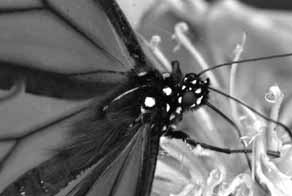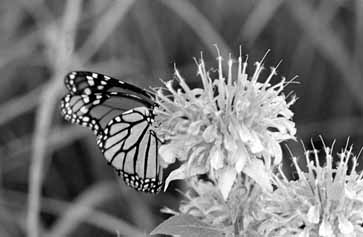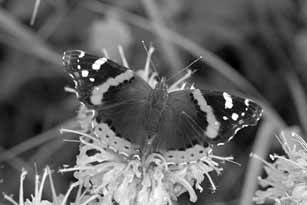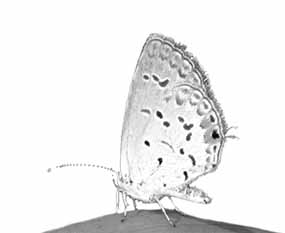ike many avid butterfly watchers, my interest started at an early age. During grade school I spent nearly every summer day roaming the Illinois Central Railroad right-of-way and the Salt Creek shoreline in Elmhurst for insects.
By high school, I had stopped mounting and preserving specimens. Instead, I was watching butterflies the way a birder watches birds, on the wing. But there's a difference: the beautiful colors and intricate patterns on butterfly wings are best viewed up close. Although butterflies often seem timid, it is surprising how often one can get very close, even close enough to coax the butterfly onto one's finger. Looking at the fine lines and spotsósoft brown, vivid orange or iridescent blueófrom a foot away is one of the great pleasures of butterfly watching.
After casually observing the butterflies during my 20 years at Fermilab, in the past few years I have begun searching the site more intensively, looking for small, local populations. With its wide variety of habitatsówetlands, prairie, and woodsóthe Fermilab site has hosted at least 44 species of butterflies during the past two years. Late summer is one of the best of times for viewing.
 Some butterflies, like the Eyed Browns living in the wetlands inside the Main Ring, are very local in distribution. These "remnant-dependent" butterflies rarely stray from the native plants on which they depend, perhaps inhabiting an area of only a few acres. The laboratory's prairie restorations now total over a thousand acres, but I've seen no true prairie-dependent species. That may be because Fermilab's prairie is an island, with no other native prairie near enough for prairie butterflies to move back and forth on their own. All the remnant-dependent butterflies I've found so far are wetland species, perhaps because there were enough wetland remnants when Fermilab was established to "re-seed" the site's developing wetlands with butterflies. This appears not to have happened for prairie species. Unlike wetland species found on site, some of these apparently delicate creatures, including the Monarchs, Red Admirals, and Painted Ladies can travel hundreds of miles.
Some butterflies, like the Eyed Browns living in the wetlands inside the Main Ring, are very local in distribution. These "remnant-dependent" butterflies rarely stray from the native plants on which they depend, perhaps inhabiting an area of only a few acres. The laboratory's prairie restorations now total over a thousand acres, but I've seen no true prairie-dependent species. That may be because Fermilab's prairie is an island, with no other native prairie near enough for prairie butterflies to move back and forth on their own. All the remnant-dependent butterflies I've found so far are wetland species, perhaps because there were enough wetland remnants when Fermilab was established to "re-seed" the site's developing wetlands with butterflies. This appears not to have happened for prairie species. Unlike wetland species found on site, some of these apparently delicate creatures, including the Monarchs, Red Admirals, and Painted Ladies can travel hundreds of miles.

One of northeastern Illinois' rarest butterflies that is breeding onsite is the Purplish Copper, a wetland species. It always seems associated on the Fermilab site with the plant, water heartsease (Polygonum coccineum). Patches of water heartsease probably survived the agricultural period here, supporting small populations of Purplish Coppers as the larval food plant. Now more of a western butterfly, Purplish Coppers have largely died out east of the Mississippi as wetlands have been destroyed. A larger relative, the Bronze Copper, is also common at Fermilab. One can see both these species flying around pond edges in late August and early September. Bullrush Pond, just north of the Central Helium Liquefier, is a particularly good place for Purplish Coppers and a convenient place for a lunchtime butterfly walk.
 The Interpretive Trail (starting at the parking lot across Pine Street from the Education Center) is a prime location for viewing a variety of butterflies from late June through August. One of my favorites, the Great Spangled Fritillary, likes the woods/prairie edge where the Prairie Trail nears the Big Woods. These large, black and orange butterflies with shiny silver spots on the underside of the hind wings fly from late June into August. A butterfly that lives in old fields but has found a home in our prairie restorations, probably feeding as a caterpillar on Big Bluestem grass, is the Common Wood Nymph. Brown with two large eyespots on each front wing, it flits through the tall grass with a funny, low, bouncing flight. A close relative, the Pearly Eye, frequents an area just a short distance away in the woods.
The Interpretive Trail (starting at the parking lot across Pine Street from the Education Center) is a prime location for viewing a variety of butterflies from late June through August. One of my favorites, the Great Spangled Fritillary, likes the woods/prairie edge where the Prairie Trail nears the Big Woods. These large, black and orange butterflies with shiny silver spots on the underside of the hind wings fly from late June into August. A butterfly that lives in old fields but has found a home in our prairie restorations, probably feeding as a caterpillar on Big Bluestem grass, is the Common Wood Nymph. Brown with two large eyespots on each front wing, it flits through the tall grass with a funny, low, bouncing flight. A close relative, the Pearly Eye, frequents an area just a short distance away in the woods.
 In Strong Opinions, the eminent Russian novelistóand gifted amateur lepidopterist Vladimir Nabokov wrote: "I have often dreamt of a long and exciting career as an obscure curator of lepidoptera in a great museum." A short walk from my office, down a trail or into the woods, the Fermilab site opens before me just such a great museum as Nabokov dreamt of.
In Strong Opinions, the eminent Russian novelistóand gifted amateur lepidopterist Vladimir Nabokov wrote: "I have often dreamt of a long and exciting career as an obscure curator of lepidoptera in a great museum." A short walk from my office, down a trail or into the woods, the Fermilab site opens before me just such a great museum as Nabokov dreamt of.
On the Web:
The Butterflies of Fermilab http://www.fnal.gov/pub/about/campus/ecology/wildlife/butterflies.html
Butterflies for Kids http://www-ed.fnal.gov/lasso/butterfly_search/

 Like many avid butterfly watchers, my interest started at an early age. During grade school I spent nearly every summer day roaming the Illinois Central Railroad right-of-way and the Salt Creek shoreline in Elmhurst for insects.
Like many avid butterfly watchers, my interest started at an early age. During grade school I spent nearly every summer day roaming the Illinois Central Railroad right-of-way and the Salt Creek shoreline in Elmhurst for insects.
 Some butterflies, like the Eyed Browns living in the wetlands inside the Main Ring, are very local in distribution. These "remnant-dependent" butterflies rarely stray from the native plants on which they depend, perhaps inhabiting an area of only a few acres. The laboratory's prairie restorations now total over a thousand acres, but I've seen no true prairie-dependent species. That may be because Fermilab's prairie is an island, with no other native prairie near enough for prairie butterflies to move back and forth on their own. All the remnant-dependent butterflies I've found so far are wetland species, perhaps because there were enough wetland remnants when Fermilab was established to "re-seed" the site's developing wetlands with butterflies. This appears not to have happened for prairie species. Unlike wetland species found on site, some of these apparently delicate creatures, including the Monarchs, Red Admirals, and Painted Ladies can travel hundreds of miles.
Some butterflies, like the Eyed Browns living in the wetlands inside the Main Ring, are very local in distribution. These "remnant-dependent" butterflies rarely stray from the native plants on which they depend, perhaps inhabiting an area of only a few acres. The laboratory's prairie restorations now total over a thousand acres, but I've seen no true prairie-dependent species. That may be because Fermilab's prairie is an island, with no other native prairie near enough for prairie butterflies to move back and forth on their own. All the remnant-dependent butterflies I've found so far are wetland species, perhaps because there were enough wetland remnants when Fermilab was established to "re-seed" the site's developing wetlands with butterflies. This appears not to have happened for prairie species. Unlike wetland species found on site, some of these apparently delicate creatures, including the Monarchs, Red Admirals, and Painted Ladies can travel hundreds of miles.

 The Interpretive Trail (starting at the parking lot across Pine Street from the Education Center) is a prime location for viewing a variety of butterflies from late June through August. One of my favorites, the Great Spangled Fritillary, likes the woods/prairie edge where the Prairie Trail nears the Big Woods. These large, black and orange butterflies with shiny silver spots on the underside of the hind wings fly from late June into August. A butterfly that lives in old fields but has found a home in our prairie restorations, probably feeding as a caterpillar on Big Bluestem grass, is the Common Wood Nymph. Brown with two large eyespots on each front wing, it flits through the tall grass with a funny, low, bouncing flight. A close relative, the Pearly Eye, frequents an area just a short distance away in the woods.
The Interpretive Trail (starting at the parking lot across Pine Street from the Education Center) is a prime location for viewing a variety of butterflies from late June through August. One of my favorites, the Great Spangled Fritillary, likes the woods/prairie edge where the Prairie Trail nears the Big Woods. These large, black and orange butterflies with shiny silver spots on the underside of the hind wings fly from late June into August. A butterfly that lives in old fields but has found a home in our prairie restorations, probably feeding as a caterpillar on Big Bluestem grass, is the Common Wood Nymph. Brown with two large eyespots on each front wing, it flits through the tall grass with a funny, low, bouncing flight. A close relative, the Pearly Eye, frequents an area just a short distance away in the woods.
 In Strong Opinions, the eminent Russian novelistóand gifted amateur lepidopterist Vladimir Nabokov wrote: "I have often dreamt of a long and exciting career as an obscure curator of lepidoptera in a great museum." A short walk from my office, down a trail or into the woods, the Fermilab site opens before me just such a great museum as Nabokov dreamt of.
In Strong Opinions, the eminent Russian novelistóand gifted amateur lepidopterist Vladimir Nabokov wrote: "I have often dreamt of a long and exciting career as an obscure curator of lepidoptera in a great museum." A short walk from my office, down a trail or into the woods, the Fermilab site opens before me just such a great museum as Nabokov dreamt of.